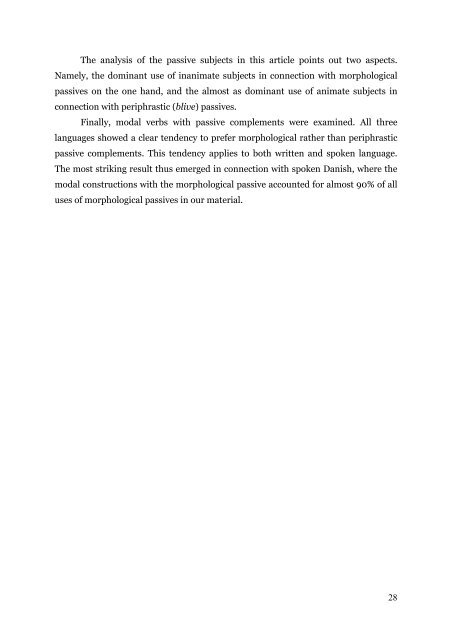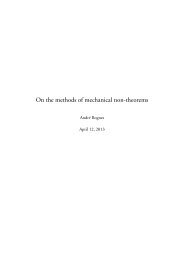<strong>The</strong> analysis of the <strong>passive</strong> subjects <strong>in</strong> this article po<strong>in</strong>ts out two aspects. Namely, the dom<strong>in</strong>ant use of <strong>in</strong>animate subjects <strong>in</strong> connection with morphological <strong>passive</strong>s on the one h<strong>and</strong>, <strong>and</strong> the almost as dom<strong>in</strong>ant use of animate subjects <strong>in</strong> connection with periphrastic (blive) <strong>passive</strong>s. F<strong>in</strong>ally, modal verbs with <strong>passive</strong> complements were exam<strong>in</strong>ed. All three languages showed a clear tendency to prefer morphological rather than periphrastic <strong>passive</strong> complements. This tendency applies to both <strong>written</strong> <strong>and</strong> <strong>spoken</strong> language. <strong>The</strong> most strik<strong>in</strong>g result thus emerged <strong>in</strong> connection with <strong>spoken</strong> Danish, where the modal constructions with the morphological <strong>passive</strong> accounted for almost 90% of all uses of morphological <strong>passive</strong>s <strong>in</strong> our material. 28
References Åfarli, Tor. 1992. <strong>The</strong> Syntax of Norwegian Passive Constructions. Amsterdam & Philadelphia: John Benjam<strong>in</strong>s Publish<strong>in</strong>g Company. Becker-Christensen, Christian. 2001. Den grædte pige og lignende historier. Om perfektum participium efter blive og være og som adled. In Pia Jarvad, Frans Gregersen, Lars Heltoft, Jørn Lund & Ole Togeby (eds.), Sproglige åbn<strong>in</strong>ger. E som Erik, H som 70. Festskrift til Erik Hansen, 119–139. København: Hans Reitzels Forlag. Biber, Douglas, Stig Johansson, Geoffrey Leech, Susan Conrad & Edward F<strong>in</strong>egan. 1999. Longman Grammar of Spoken <strong>and</strong> Written English. Harlow: Longman. Biber, Douglas. 1988. Variation across Speech <strong>and</strong> Writ<strong>in</strong>g. Cambridge: Cambridge University Press. Bjerre, Anne & Tavs Bjerre. 2007. Perfect <strong>and</strong> periphrastic <strong>passive</strong> constructions <strong>in</strong> Danish. Nordic Journal of L<strong>in</strong>guistics 30.1, 5–53. Br<strong>and</strong>t, Søren. 1999. Modal Verbs <strong>in</strong> Danish. København: C. A. Reitzel. Chafe, Wallace & Deborah Tannen. 1987. <strong>The</strong> Relation between Written <strong>and</strong> Spoken Language. Annual Review of Anthropology, vol. 16, 383–407. Comrie, Bernard. 2008. What is a Passive? In Zar<strong>in</strong>a Estrada Fernández et al. (eds.), Studies <strong>in</strong> <strong>voice</strong> <strong>and</strong> transitivity (L<strong>in</strong>com Studies <strong>in</strong> <strong>The</strong>oretical L<strong>in</strong>guistics 39), 1–18. Muenchen: L<strong>in</strong>com Europa. Diderichsen, Paul. 1962. Elementær dansk grammatik. København: Gyldendal. Engdahl, Elisabet. 1999. <strong>The</strong> choice between bli-<strong>passive</strong> <strong>and</strong> s-<strong>passive</strong> <strong>in</strong> Danish, Norwegian <strong>and</strong> Swedish. NORDSEM Report 3. http://www.l<strong>in</strong>g.gu.se/~engdahl/passiv-w (26.06.01) Engdahl, Elisabet. 2000. Valet av passivform i modern svenska. Svenskans beskrivn<strong>in</strong>g 24, 81–90. L<strong>in</strong>köp<strong>in</strong>g Electronic Conference Proceed<strong>in</strong>gs. http://www.ep.liu.se/ecp/006/007/ecp00607b.pdf Engdahl, Elisabet. 2001. Sc<strong>and</strong><strong>in</strong>avian Passives <strong>in</strong> HPSG. In Arthur Holmer, Jan-Olof Svantesson & Åke Viberg (eds.), Proceed<strong>in</strong>gs of the 18th Sc<strong>and</strong><strong>in</strong>avian Conference of L<strong>in</strong>guistics, vol. 2, (Travaux de l'<strong>in</strong>stitut de l<strong>in</strong>guistique de Lund 39:2), 23–36. Lund: Universitetstryckeriet. Engdahl, Elisabet. 2006. Semantic <strong>and</strong> syntactic patterns <strong>in</strong> Swedish <strong>passive</strong>s. In Lyngfelt, Benjam<strong>in</strong> & Torgrim Solstad (eds.), Demot<strong>in</strong>g the Agent. Passive, middle <strong>and</strong> other <strong>voice</strong> phenomena, 21–45. Amsterdam & Philadelphia: John Benjam<strong>in</strong>s Publish<strong>in</strong>g Company. Enger, Hans-Olav. 1998. Forholdet mellom presens s-form og <strong>in</strong>f<strong>in</strong>itiv s-form. Maal og M<strong>in</strong>ne 2, 193– 206. Enger, Hans-Olav. 2001. Om s-<strong>passive</strong>ns relasjoner til modalitet, aspekt og kasus. Tijdschrift voor Sk<strong>and</strong><strong>in</strong>avistiek 22.2, 411–433. Engh, Jan. 1994. Verb i passiv fulgt af perfektum partisipp. Bruk og historie. Oslo: Novus Forlag. Faarlund, Jan Terje, Sve<strong>in</strong> Lie & Kjell Ivar Vannebo. 1997. Norsk referansegrammatikk. Oslo: Universitetsforlaget. Hansen, Aage. 1967. Moderne Dansk. Vol.3. Grafisk Forlag. Heltoft, Lars. 1994. S-modus og perifrastisk modus. In Nils Jörgensen, Christer Platzack & Jan Svensson (eds.), Språkbruk, grammatik och språkförändr<strong>in</strong>g. En festskrift till Ulf Teleman, 155– 165. Lund: Lund University. Heltoft, Lars. 1996. Paradigmatic structure, word order <strong>and</strong> grammaticalization. In Elisabeth Engberg-Pedersen et al. (eds.), Content, Expression <strong>and</strong> Structure. Studies <strong>in</strong> Danish Functional Grammar, 469–494. Amsterdam & Philadelphia: John Benjam<strong>in</strong>s Publish<strong>in</strong>g Company. Heltoft, Lars & Lisbeth Falster Jakobsen. 1996. Danish <strong>passive</strong>s <strong>and</strong> subject positions as a mood system. A content analysis. In Elisabeth Engberg-Pedersen et al. (eds.), Content, Expression <strong>and</strong> Structure. Studies <strong>in</strong> Danish Functional Grammar, 199–234. Amsterdam & Philadelphia: John Benjam<strong>in</strong>s Publish<strong>in</strong>g Company. Henrichsen, Peter Juel & Jens Allwood. 2005. Swedish <strong>and</strong> Danish, <strong>spoken</strong> <strong>and</strong> <strong>written</strong> language: A statistical comparison. International Journal of Corpus L<strong>in</strong>guistics 10.3, 367–399. Holm, Gösta. 1952. Om s-passivum i svenskan. Lund: Gleerup. Holm, Gösta. 1967. Om s-passivum i svenskt talspråk. In Gösta Holm (ed.), Svenskt talspråk, 204– 225. Stockholm: Almqvist & Wiksell. Holmberg, Anders. 2002. Expletives <strong>and</strong> Agreement <strong>in</strong> Sc<strong>and</strong><strong>in</strong>avian Passives. Journal of Comparative Germanic L<strong>in</strong>guistics 4, 85–128. Hovdhaugen, Even. 1977. Om og omkr<strong>in</strong>g passiv i norsk. In Thorste<strong>in</strong> Fretheim (ed.), Sentrale problemer i norsk syntaks, 15–46. Oslo: Universitetsforlaget. Hulthén, Lage. 1944. Studier i jämför<strong>and</strong>e nunordisk syntax. Göteborg: Göteborg University. 29

















